 |
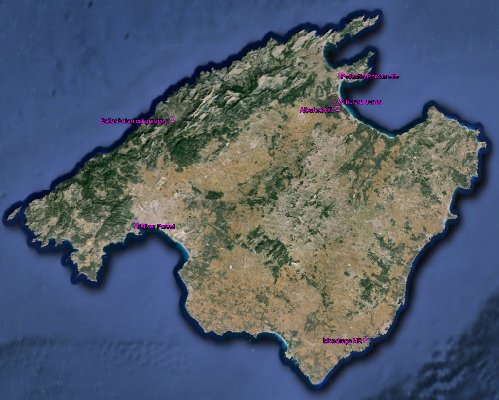
A holiday trip to Majorca provided some good orchid spotting opportunities, and some disappointments. The dates, 4-11th of April, does seem to have been a good choice, though a single week will rarely cover all native species, - however only Spirathes spiralis would definitely not be found. The holiday itinerary had trips to gardens and nature reserves, and I hoped for chance findings at other places visited. However, Majorca is not like Corfu where roadsides, traffic islands and bus stops could boast orchid communities.
I did some research beforehand, but information on the best places to visit for orchids is a bit patchy on the net. Some references seemed to have even been incorrectly located. Bus travel across the island is reasonable, but won't get you into the remoter mountains. We did have a hire car for part of the week, but getting to other places meant that one good hillside location near Galilea in the south-west mentioned by two sources dropped off the list. However, the species mentioned there were seen by us elsewhere.
In all 16+ species were noted, over four genera, counting one likely Ophrys which had finished and one likely Orchis still in tight bud. Seven were species I had not seen before.
The Natural History Museum Botanic Gardens, Soller
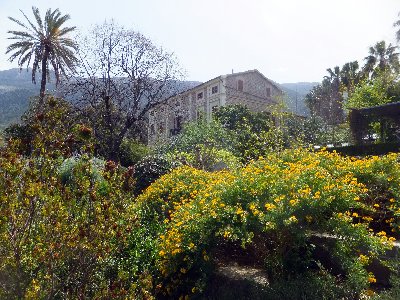
This is well worth a visit, especially if you are traveling from Palma on the vintage train into the mountains, which includes a transfer to the equally vintage tram which takes you down to Port de Soller. They have a number of plots, each recreating a Balearic habitat with many of the wild plants that grow there. There are wild orchids in two of the areas, but they do not represent anything like the full complement of orchids found on the islands. And perhaps it is a bit of a cheat to 'spot' orchids this way. some species seemed to have failed to survive, and those left were some of the commoner species, perhaps surviving because they are more tolerant of a range of conditions.
The Serapias linguas were most successful, and could be found with a pale pink veined tongue and very deep pink cowl, or with a deeper pink tongue. Ophrys speculum, the Mirror Orchid, also appears to be a more successful planting. I was surprised to see how small this species actually was. Also in flower were Ophrys bombilifera and Orchis italica. The plants labeled Ophrys fusca there were probably O. bilunulata due to the outlined W-shaped speculum; O. fusca I have seen before in Puglia, but O. bilunulata was welcome new species.
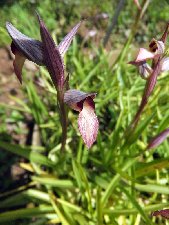 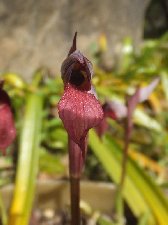 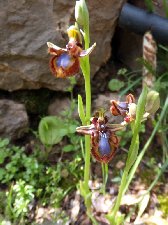 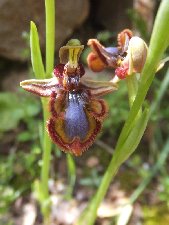
Serapias lingua Ophrys speculum
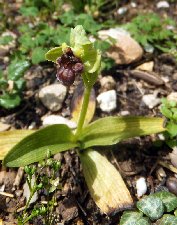 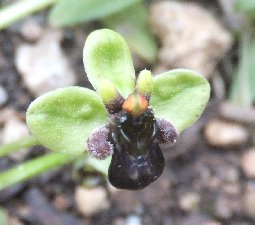 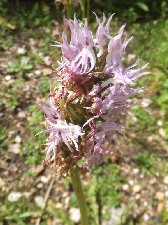
Ophrys bombilifera Orchis italica Ophrys bilunulata
Pollentia Roman town, Alcudia
Just outside the town walls of Alc£dia on the north of the island lie the only Roman remains on Majorca. I had hopes of finding some orchids as we made our way between the excavated areas. There were a few Barlia roberstsiana growing in the undisturbed areas. They had mostly gone over but at least one showed how the flowers should appear.
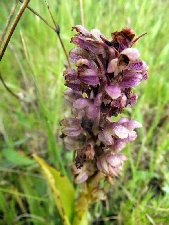  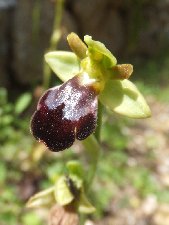
Albufera Nature Reserve, Alcudia.
A huge reserve, at least in relation to the island size, that used to frequently flood in ye olden dayes. It principally attracts birders, in particular those into water fowl. However there were reports of orchids here, as well as planted specimens behind the information office. Before we found those a few Ophrys speculum and O. bombylifera were spotted growing naturally in the wild flower beds.
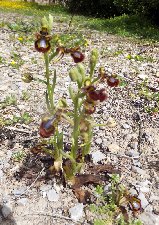 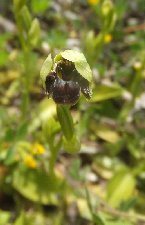
Again, artificial plantings of wild orchids do not seem to have gone all to plan. In addition to some nearly finished flowering or still in bud, some had patently passed away while others had been rabbit-nibbled. In the wild an orchid community will have more shaded or drier spots which means examples can be found flowering over a much wider time frame than a few growing in a single spot with equal sunlight and equally watered. Hence although this again was a cheat, it was a shame to not see a display of all of them in flower. However it was a good range of orchids with more than at the NH gardens.
Barlia robertsiana - gone over
Ophrys tenthenifera - finished and nibbled
O. balearica - last few parts of flowers hanging on
O. speculum - decent display
O. lupercalis - finished and/or nibbled
Orchis italica - nice display
O. robusta - in bud and looking okay
O. fragrans - in bud
Anacamptis x albuferans - in bud (Anacamptis palustris ssp. robusta and Anacamptis coriophora ssp. fragrans.)
Again one can see the same species as at the botanical gardens are in flower and doing well. Both the planted sites demonstrated an important point. We saw some species in flower, some gone over and some in bud. They all get the same exposure to the weather. However in the wild one can see a bigger range in flower simply because some grow in exposed spots, others in sheltered spots, and the rest in all shades between. Basically, if a species grows in the wild you have a much better chance of spotting it in flower over a wider time frame.
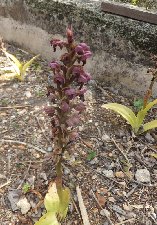 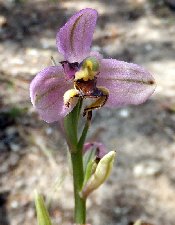 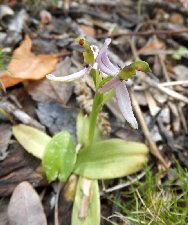 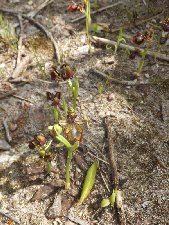
Barlia robertsiana Ophrys tenthenifera Ophrys balearica Ophrys speculum .
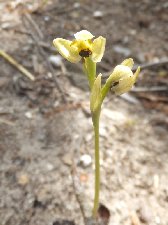 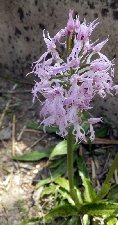 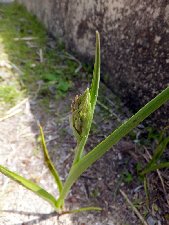 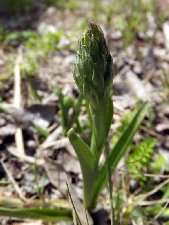 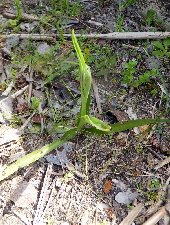
Ophrys lupercalis Orchis italica Orchis robusta Orchis fragrans Anancamptis x albuferans ,
At the information office we asked where the orchids grew. Despite a picture of a Southern Marsh Orchid on the reserve's map leaflet we only got a 'perhaps around here' pointing to a spot on the reserve map. We had to double back along the path halfway towards the road (the info desk is 1.1 km from the car park) and turn right. About 1.5-2km along a straight track with no midday shade you come to a copse with sandy soil with No Entry (in Spanish) signs! After being directed there we decided to tread daintily and see what grew. There were a number of Ophrys speculum, Orchis fragrans in bud (identified only by the deep red colour of the barely emerging flowers in a few) and Serapias lingua. A quick scan of the reserve from one of the bird viewing platforms showed nothing else likely for orchids, just reed beds for miles. Back to the info desk for the toilets and then the 1 km trek back to the car park. And just for information, there's no drinks on sale at the information office.
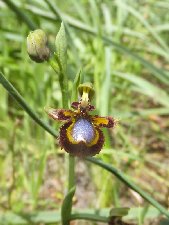 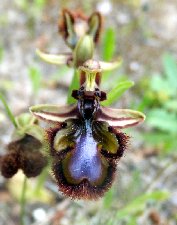 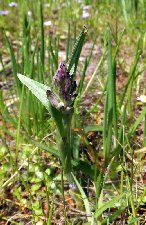 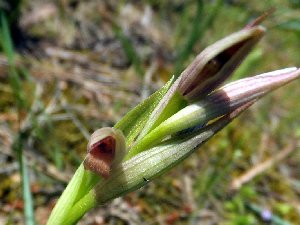
Albufera Dunes, Alcudia
Arriving back at the main road, I noticed that on the other side a path ran alongside the river down to the sea, and it looked promising. The edges of the path were fruitful, and so was the small dune area (undergoing restoration) which merged into beach. Here we saw more Barlia robertsiana past flowering, Orchis fragrans in nearly full flower (probably due to the much more open aspect in full sun), Serapsia lingua with pale orange tongues, and more Ophrys speculum.
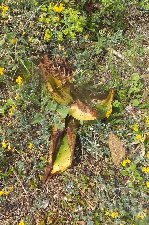 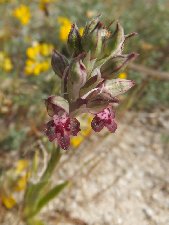 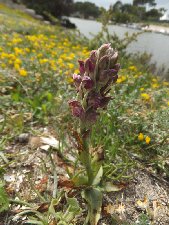 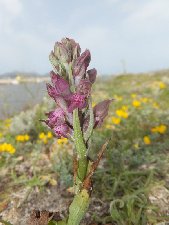
Barlia robertsiana Orchis fragrans in flower .
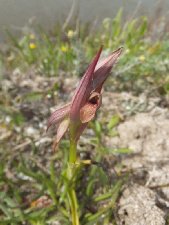 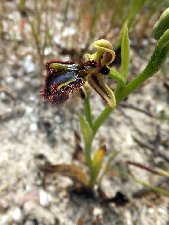 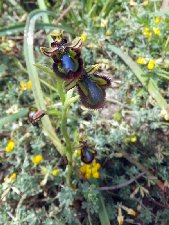
Serapsia lingua Ophrys speculum .
Thus this little diversion was more fruitful than the nature reserve itself in terms of species and numbers. and if you are not into planted specimens tou can free up a couple of hours for elsewhere - such as the coastal pines and scrub about a mile or so towards Can Picafort.
Bellver Forest, Palma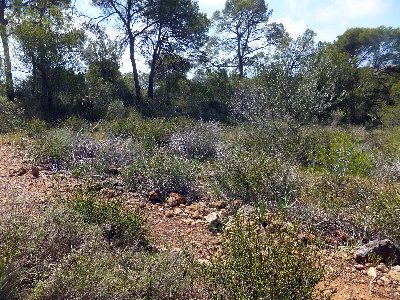
At the Botanic gardens I bought a book entitled The Orchids of the Bellver Forest which proclaimed that 18 of the 20 commonest orchids of the Majorcan plains could be found there, with many of them easy to spot. This is a hill, surmounted by a castle, with roads and paths winding their way through pines, olives and scrub, with a few open spots in full sun. Sounded good, but then reality kicked in. A first trip in the evening was a bit disappointing in recording just two species, with a second and third trip fitted in (our hotel was within walking distance of the gates) noting seven species in total. And not only were no sizable colonies found, but we didn't find two species that are rarities and were on a must see list -the Dense-flowered Orchid and the Violet Limodore. Were we there at the wrong week? Possibly, but unlikely. We scouted wide areas on the landward and southern sides without much success.
What did we see? There were Serapias lingua with nice pink-veined orange tongues and an array of other colours, and Ophrys speculum at various spots. Then there was a small group of flower spikes, well past their best, but tentatively identified as Orchis longicornu from the length and shape of the remaining spur. A small clump of Orchis conica was in better, but not perfect condition, and we spotted Ophrys bombilifera and S. parviflora at several locations on the hillside. The seventh species was one seen at several spots and was in tight bud. Clearly it was an Orchis species, definitely not Ophrys nor Anacamptis, but the only likely contender, being a later flowering orchid, is Orchis fragrans. However these seemed just be one size too large unless they were old well established plants.
So that makes 7 species out of 18, which is a tad disappointing.
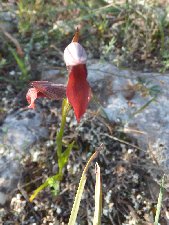 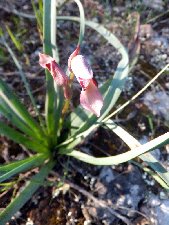 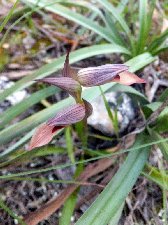
Serpsias lingua in various colours (note the insect)
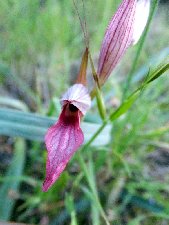 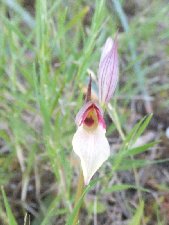 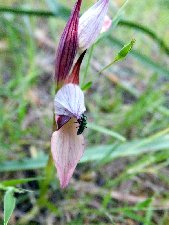
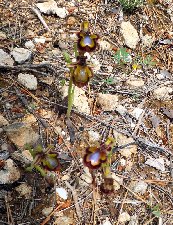 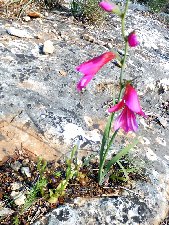 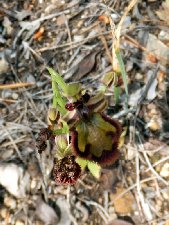
Ophrys speculum with Wild Gladiolus for scale
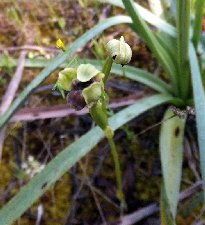 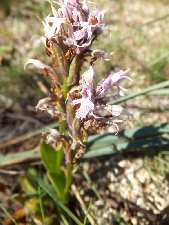 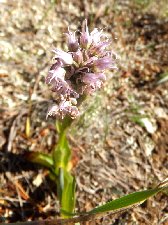
Ophrys bombilifera and Orchis conica
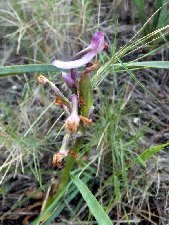 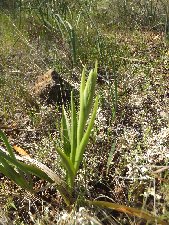
Remains of O. longicornu(?) and unknown Orchis in tight bud
Mondrago Nature Reserve
This reserve is down in the south east corner of Majorca, near Santanyi. We arrived on a dull morning and by the time we finished it was lashing down and we were quite wet. This did mean that we had several square miles of natural habitat to ourselves. Directions to the reserve took us the longest way around and we ended up in the car park we didn't want to use. The one with the information desk was two miles away, but luckily there were portaloos at this one. And these was a nice big board with a map detailing a number of walks, and telling us that 10 species of orchid grow there. As one was Autumn Lady's-tresses that left nine to find. We managed 3 of the 5 walks, and one of the remainder was more a path from car park to beach.
First off Anacamptis pyramidalis could be found here, there, and everywhere. They seemed larger than in the UK, paler and more loosely flowered, and not very pyramidal at all. Some were globose and others rather columnar. Serapias lingua was also a frequent find, and they displayed a large range of tongue colouration - pale, nearly white, yellow, deep crimson or pale orange, as well as the usual range of pinks, with or without veining. Also seen dotted across the site were Ophrys speculum, O. bombilifera, and one species that had already setting seed. This could have been O. fusca which flowers earlier than others of the genus and is known to grow there. The prize orchid of Mondrago though was O. balaerica. Very similar to O. bertelonii, these grew in discrete colonies with some nice tall specimens. There was quite a bit of colour shade variation to the petals and sepals, from near white to deep pink, even within a discrete sub-colony. The speculum shape also varied from horseshoe to fat Ws to bat-signal shapes even! The O. tenthredinifera (the Sawfly Orchid) seen were a bit past their best, and in shade, and found when it was raining hard. Hence the photos taken are way below standard; a bit of a shame.
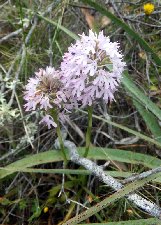 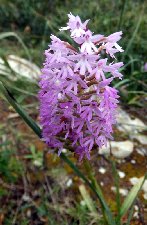 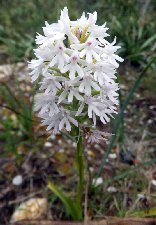
The pale and globose or columnar A. pyramidalis inflorescences
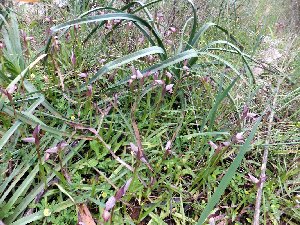 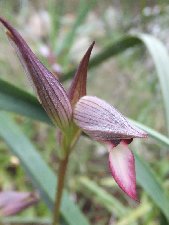 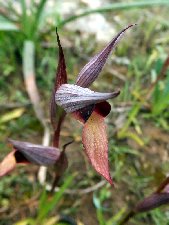 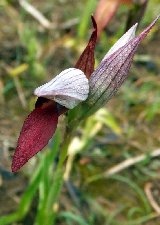
The range of colours of the tongues of the S. linguas
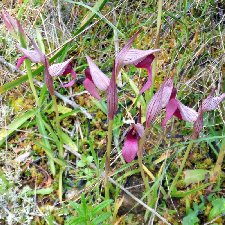 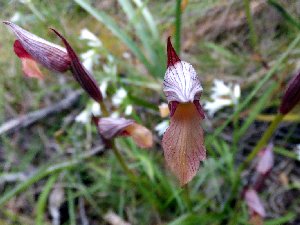 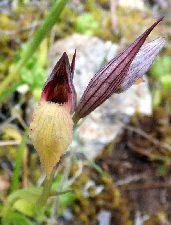 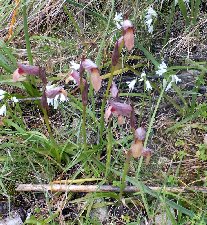
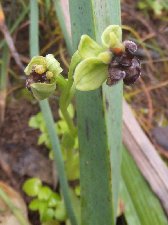 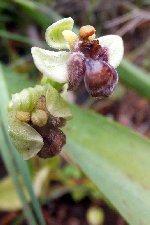 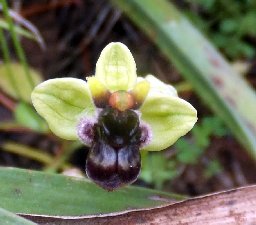
Ophrys bombilifera, the Bumblebee Orchid
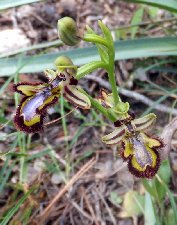 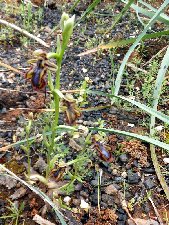
Ophrys speculum
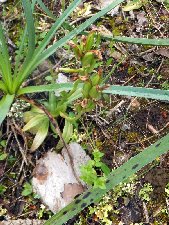 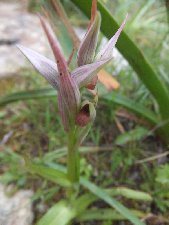 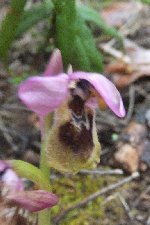
The gone-over Ophrys, Serapias parviflora, and Ophrys tenthredinifera
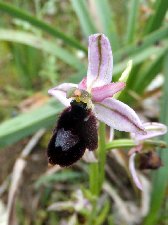 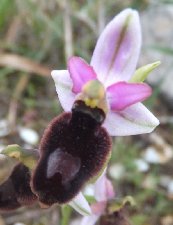 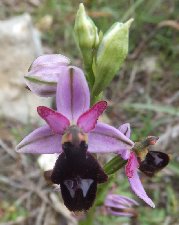 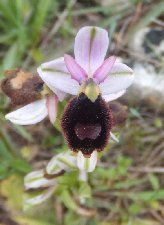
The range of sepal and petal shades and shapes, and speculums of Ophrys balearica
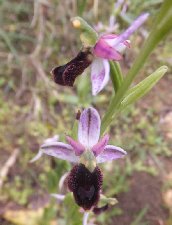 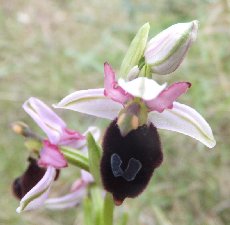 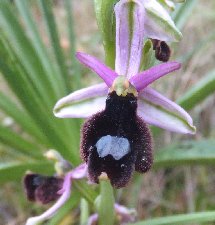 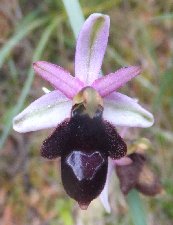
and plant forms and habitat
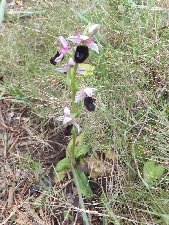 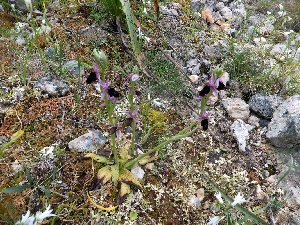
Mondrago also provided me with three `puzzle-plants'. By this I mean that they do not seem to feature in the text books. The first (right) was a slender, perha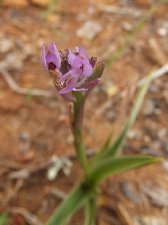 ps young, plant where the flowers were a little past their best. The lateral petals, which are angled quite distinctively, should provide a hint, but the only species that could match and be a Balaeric resident is Orchis collina. This does grow in the islands, but it's a long shot, and the colour is just not quite right. ps young, plant where the flowers were a little past their best. The lateral petals, which are angled quite distinctively, should provide a hint, but the only species that could match and be a Balaeric resident is Orchis collina. This does grow in the islands, but it's a long shot, and the colour is just not quite right.
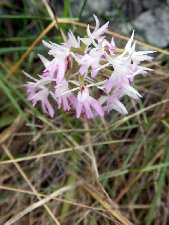
The second (left) seemed at first to be an Anacamptis pyramidalis, but is definitely atypical. Others with more experience than me say that one does find Pyramidals here taking that form. Therefore my supplementary quation has to be why no variety name for this weirdo?
The third puzzle, pictured below, was growing with a colony of Ophrys balaerica, but stood out sufficiently enough for me to suspect that it was a different species. The sepals are near white, rare in O. balaerica, and the lip shape is quite different from the usual upturned-ness of the bertelonii group of Ophrys. It is quite broad towards the tip, while O. balaerica's doesn't widen appreciately. The speculum is bright pale blue with a white edging - compare to the O. balaericas above. However no species in neither Delforge or Davies & Huxley look good candidates or can be found in the Balaerics.
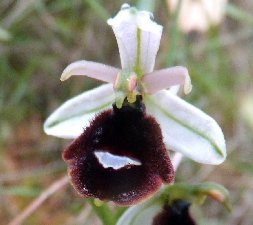 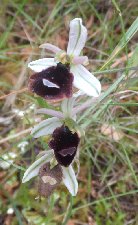
   
|
























































































